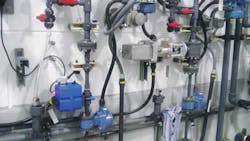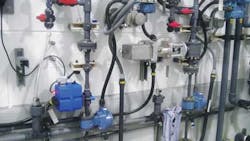Saving Big With Thermoplastic Control Valves
By Ed Cellucci
Within the water treatment industry there is a balance between cost and accuracy. Today regulatory agencies have impacted the decision-making process as there is no longer tolerance for inaccuracy, especially with regard to the dosing and concentration of chemicals used for minimizing cryptosporidium, bacteria, mold and other contaminating organic materials.
Chemical dosing and control have been achieved by various methods. The use of either metering with double diaphragm/peristaltic or centrifugal pumps has been effective, depending upon accuracy and throughput needed. Traditionally, centrifugal pumps with VFD (variable frequency drives) have not been used due to their inability to accurately control flows at the low levels needed for disinfection while still maintaining usability and, with water treatment, taste. This has recently changed, however, with control valves now able to dose very low flows with very high accuracy made possible by the use of fine control elements and sophisticated electronics.
The considerations in control valve selection for sodium hypochlorite (NaOCl) and other chemicals are multifaceted with hysteresis, accuracy, throughput, chemical compatibility and reliability taken into consideration. Historically, it's been accepted that if the correct metal valve with sliding seals were selected and were robust enough, there would be no question of it being the best selection for the process. Those thoughts were reinforced by metal valve improvements which allowed them to be used as control valves (though subject to corrosion and other reliability concerns).
With the advent of thermoplastics, and in particular thermoplastic valves, corrosion and reliability issues have been addressed and have allowed for the introduction, in 2009, of a new way to economically control aggressive chemicals.
Today there are low cost thermoplastic valves that are well suited to better service life and have better control characteristics than most if not all of the stainless steel choices available.
Hysteresis and accuracy have been addressed via actuator electronics and characterization of thermoplastic ball valves. In particular the v-notch characterized ball or custom characterized ball can give better control with better total throughput capacity than the standard metal needle valve.
Case Study
Investigating the significant performance differences between metal and thermoplastic control valves, a water treatment facility in the Salt Lake City, UT, area decided to try a thermoplastic v-notch control valve as a replacement for a Hastalloy C control needle valve that was not giving the desired accuracy or repeatability. The thermoplastic control valve was compared side by side to the metal one and was found to be 80% more accurate and significantly more reliable than its metal counterpart.
Following the test, with hysteresis, accuracy, flow capacity, chemical compatibility and reliability considered, the thermoplastic valve was selected and is currently delivering 8% concentration of sodium hypochlorite at varying flows, at times near 5 gph depending upon the fluid filter backwash stream, and consistently achieving a 0.7 ppm concentration of sodium hypochlorite in a 10 million gallon reservoir.
In addition to minimizing the potential for EPA fines, the improved performance has translated into real savings of up to 17,520 gallons of sodium hypochlorite at 8% concentration per year for each dosing system. With five systems in service, the municipality has a total volume savings of 87,600 gallons of sodium hypochlorite at a cost savings of over $64,000 per year.
The enhanced performance was achieved with a greater than 50% price reduction compared to the existing metal control valves. (Note: the thermoplastic valve was supported by the piping system with no need for additional mechanical support.)
The positive financial impact in reducing chemical usage and the minimized risk of EPA fines was significant enough to inspire the municipality to switch to thermoplastic control valves for all its critical sodium hypochlorite control applications.
About the Author: Ed Cellucci is National Sales Manager Plast-O-Matic Valves, Inc.
WaterWorld Articles Archives

